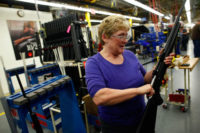Firearm manufacturing has come a long way from the days when a room full of gunsmiths was needed to ensure accurate, quality weapons. Nonetheless, manufacturing parts for firearms still requires a deep understanding of how the many small parts work together to create a successful weapon.
Springs and stamped parts make up a large percentage of today’s firearms. There can be as many as 20 springs in a typical weapon. These may include:
- Compression springs to resist applied compression forces or to store energy for pushing.
- Helical extension springs to store energy and exert a pulling force.
- Torsion springs with coils that are twisted rather than pulled to store energy.
They can be as small as a compression spring with a 0.05 inch OD or as large as a recoil spring that is 2.5 feet long. Springs are essential to the operation of such components as the ejector, magazine and recoil assembly. Springs must perform properly in the limited space available in most firearms, and they must be durable enough to sustain repeated use.
Firearms springs can be made with music wire, high-tensile rocket wire or stranded wire. They can be made from many materials, depending upon the application. Chrome silicon, 17-7 PH stainless steel and 17-4 PH stainless steel are the most frequently used materials because of their strength, durability and corrosion resistance.
Stamped firearms parts include trigger bars and assemblies; slide stops with springs; and safety assemblies. Like springs, stamped parts also must operate within a constrained space. For example, trigger bars must fit within the envelope of the gun and not interfere with the spring. The link from the trigger to the sear (the part of the trigger mechanism that holds the hammer back until the correct amount of pressure has been applied to the trigger) has a narrow profile to operate properly without getting in the way of the trigger bar components.
Development and Prototyping
The key to producing quality firearm springs and stamped parts is engineering and support services, including making recommendations to improve manufacturability throughout the design and development process.
A good design process depends on good communication. After the initial contact, the customer sends a drawing or CAD file, and our experts will offer feedback about the design and the need for secondary operations or machining. There may be several meetings or conference calls, when everyone can look at the drawing and make changes. Working through all these changes may take numerous online meetings or face-to-face visits. Prototyping is then used to assist the customer get the right design. During prototyping, two or three variations may be tested at one time.
Many initial firearm spring designs are overstressed. That’s because designers typically want to do more than is theoretically possible within the small amount of space assigned for the spring. However, with an overstressed design, the spring will take a permanent set, losing its length and load. To guard against this, significant development and prototyping is necessary.
For example, one major firearms manufacturer initially wanted to make a recoil spring for a 40 mm pistol from standard music wire. However, such wire typically does not have enough tensile strength to support the load requirements for that application, and testing indicated the spring could not take the shock.
During consultation and prototyping, our engineers recommended the use of chrome silicon flat wire. Widely used to make pistons in the automobile industry, chrome silicon can withstand more heat and shock than music wire. The design process included several rounds of prototypes. Ultimately, the firearms manufacturer adopted the recommendation, and the spring made from chrome silicon flat wire was successful.
A successful development process is also helped by knowledge of the gun industry and experience with the interaction of parts in a weapon. Knowing the variations in how a similar part works across many firearms helps when it comes time to design a new one.
For example, many firearms manufacturers are designing smaller, slimmer weapons that are meant to be concealed. Calling on knowledge gained from designing medical and surgical tools, where there is also little room to work, we have been able to steer firearms engineers towards designs that can be successfully manufactured.
Another industry trend is the use of polymers in pistols to reduce cost and weight. In this case, our engineers often recommend stamped front and rear struts to provide the reinforcement needed for a lighter weight firearm with no steel frame. Stamped struts strengthen the polymer frame without the need to machine the entire front of the frame.
Consistent Manufacturing
It takes a great deal of technical expertise to get consistency in firearm springs and stamped parts. The 127,000th part must be just like the first, and a firearm must still work if a replacement part is inserted.
Lasers, probes and other measurement devices are used to monitor our stamping, forming and machining operations. If a process hits a point where the Cpk is outside of specifications, it shuts down until corrected.
One of the most important processes for making springs and stamped parts for firearms is heat treating. This process is frequently used to alter the material’s physical properties so the part’s shape and size meet specifications.
For example, one customer wanted to use 302 stainless steel for a new gun’s magazine spring. The new weapon was to be made entirely from stainless steel components, so it would be completely corrosion-resistant. Our engineers determined that the original design would not meet the manufacturer’s requirements. It would be unable to handle the load. As an alternative, our engineers suggested the spring be made from 17-7PH stainless steel, heat treated at 900 F to add strength to take the higher load.
Heat treating can also correct distortion that can occur in a spring due to the extreme stress placed on wire during forming. For example, when magazine springs are formed, they are often distorted and may not meet the print specification. To correct this, spring manufacturers can intentionally introduce stress into the springs by forming them in a distorted fashion. Then, the springs can be heat-treated in an inline oven to relieve that stress. After heat treating, they take on the correct shape.
Over a six-month period, numerous prototypes were developed and tested; the design was modified and improved to get the load and compression the customer wanted. Deflection and travel tests were conducted, and a short run of parts was made from both materials to see which would work better. The customer eventually selected the 17-7PH spring. Although the new spring cost more, the gun was released recently to great acclaim.
Heat treating is also used for stamped parts. For example, a trigger bar may be stamped flat, but it can distort when heat treated. The correct heat treat process must be used to ensure the part will be the correct thickness.
For more information on springs, read these articles:






